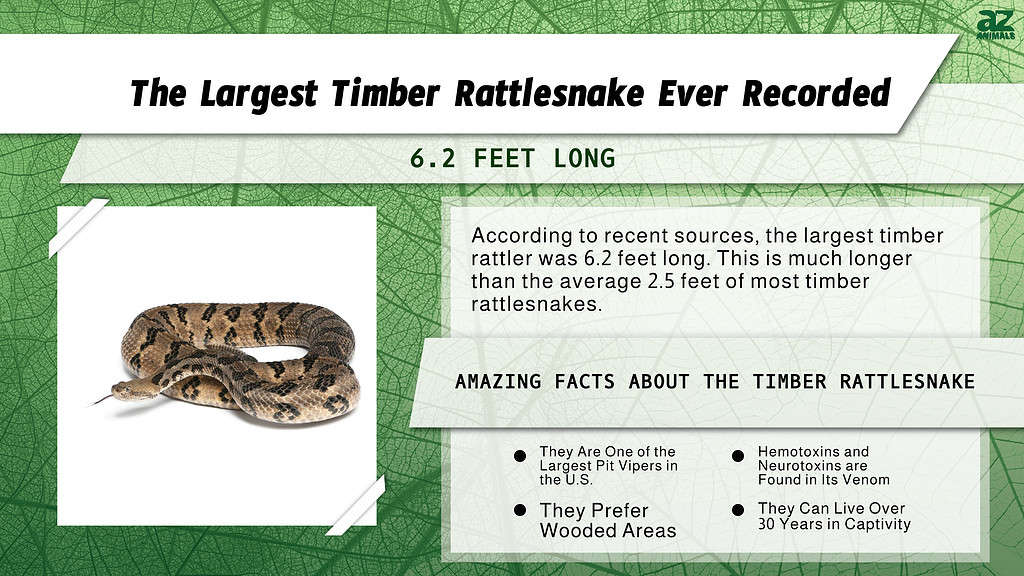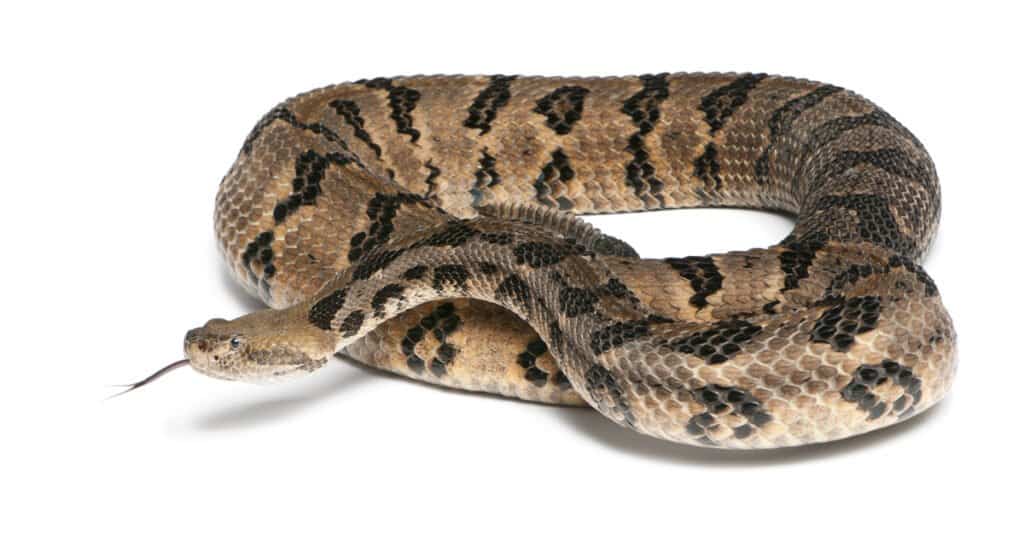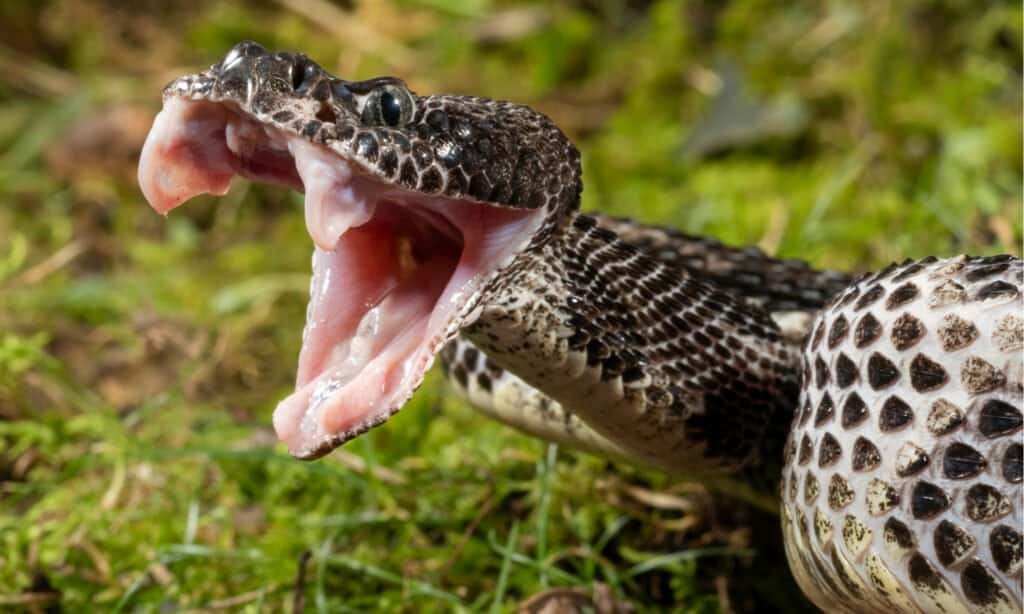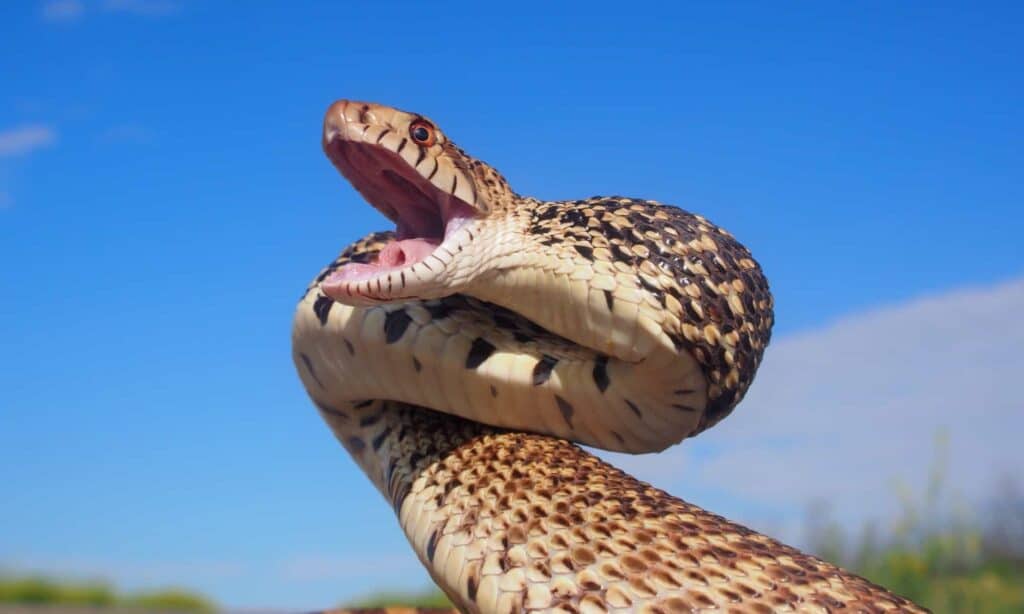Key Points:
- Timber rattlesnakes are also known as the American viper, black rattlesnake, canebrake, eastern rattlesnake, or timber rattler.
- Typical of a pit viper, these snakes range between 3-5 ft long and are hefty in size.
- While timber rattler bites are rare, their venom is lethal to humans if untreated.

One of the largest pit vipers in the eastern United States, the timber rattlesnake is also known as the American viper, black rattlesnake, canebrake, eastern rattlesnake, and timber rattler. Hemotoxins and neurotoxins are found in the venom of this snake, targeting circulation and nervous system function. There are several detrimental effects that this venom has on people. The venom of the timber rattlesnake is powerful enough to kill a human.
The timber rattlesnake, like many pit viper species, is big and bulky in form. The usual length of a timber rattlesnake is between three and five feet. However, it has been reported that these snakes have grown significantly larger.
Largest Timber Rattler Ever Recorded

According to sources, the largest timber rattler ever recorded is around 6.2 feet.
©Eric Isselee/Shutterstock.com
The record for the biggest timber rattler was 6 feet, but, according to the most recent sources, the largest discovered to date is around 6.2 feet. Adult timber rattlesnakes are around 2.5-5 feet long on average, weighing between 1.1–3.3 lb. Most mature timber rattlesnakes are seen to be on the lower end of that spectrum. There have been stories of these snakes reaching up to 7 feet long. However, these claims are not substantiated.
Timber Rattlesnake

Timber rattlesnakes have a black, green, and brown scaling pattern.
©Scott Delony/Shutterstock.com
Appearance
The timber rattlesnake has 21–26 rows of dorsal scales in the middle of its body. The head of a timber rattlesnake is yellow, brown, or gray, with a dark line extending from each eye to the jaw. Yellow, tan, brown, or gray are some of the most common colors on their bodies. As the creature gets closer to the tail, its dark patterns become more V-shaped in appearance.
Habitat
In the eastern United States, timber rattlesnakes can be found from East Texas to North Florida. This species prefers deciduous forests with steep terrain as its primary habitat. Males and non-gravid females prefer deep wooded places with a more closed forest canopy, while pregnant females prefer open, rocky ledges with higher temperatures.
Diet

Timber rattlesnakes prey mostly on small mammals.
©Joe McDonald/Shutterstock.com
Aside from other snakes, the timber rattlesnakes’ primary prey is small mammals such as squirrels and rabbits. Even though they can eat other rattlesnakes, garter snakes are the most common food of timber rattlers. Logs that have fallen in a forest are commonly used as a perch from which timber rattlesnakes can strike their victim from an elevated position. Timber rattlesnakes, like many rattlesnakes, use chemical cues to locate ambush places and attack and track their prey until they are eaten. In addition to ground-dwelling birds like bobwhites, many passerine species have been documented as being hunted alongside mammals.
Danger
The venom of the timber rattlesnake, like that of other vipers, is lethal to humans. However, bites from a timber rattlesnake are quite uncommon. For example, timber rattlesnakes avoid human contact by remaining motionless or fleeing as much as possible. Getting bitten by a timber rattler can be harmful, but it’s extremely rare to die as a direct result. However if left untreated, the bite can cause serious health complications. For instance, swelling and blackening of the skin near the bite site are common occurrences. Medical assistance should be sought as soon as possible if a venomous snake has bitten a person or animal to reduce the amount of tissue damage that may result.
How Long Do Timber Rattlesnakes Live?
These pit vipers generally live for about a decade in the wild or even up to two decades. However, that original figure can actually triple in captivity and a timber rattlesnake housed in a facility can live for up to 30 years or even longer. They have actually been known to have a lifespan of 37 years, in the latter instance.
Snakes Mistaken for Timber Rattlesnakes

Prairie kingsnakes are often mistaken for rattlesnakes.
©Matt Jeppson/Shutterstock.com
Venomous snakes can be fooled by nonvenomous snakes that “mimic.” There are various nonvenomous snakes that look like timber rattlesnakes. Snakes are notorious for doing this. Prairie kingsnakes, for example, resemble rattlesnakes because of their comparable defensive behavior. When they feel threatened, they create an S-shape and vibrate their tails on dry leaves. They too have light, unmarked bellies like the timber rattler.
The gopher snake bears a striking resemblance to the timber rattlesnake with its transverse, square, or diamond-shaped markings. There’s one distinct difference: if the gopher creates a rattling noise, it does so with its mouth rather than its tail. Gopher snakes also don’t elevate their tails while rattling but keep them lower to the ground. In comparison to rattlesnakes, the markings on the gopher are more distinct and darker.
Distinguishing Types of Rattlesnakes in the US
In North America, there are 15 species of rattlesnake, all venomous vipers. Easy ways to tell them apart are by where you are on the continent, coloration, size, and habitat. Rattlesnakes are thought to only inhabit the southwestern part of the U.S. into Mexico, however, several species inhabit the southeast up into the east coast pine and coastal forests. If you plan on traveling in the country and participating in outdoor activities, familiarize yourself with snakes in the area, especially these guys, so you can easily identify and react properly if you come across one.
Conclusion

Timber rattlesnake populations continue to fall in several Appalachian states in spite of their protected status
©Joe McDonald/Shutterstock.com
The timber rattlesnake is categorized as endangered in several states, including Connecticut, Illinois, Indiana, Massachusetts, New Hampshire, New Jersey, New York, Vermont, and Virginia. Only one colony of timber rattlesnakes remains in the entire state of New Hampshire, having been eradicated from Maine and Rhode Island. In many Appalachian states, they are protected from extinction, yet their numbers continue to dwindle. This is a pity, as they are essential to our ecosystem’s functioning. While out for a walk, if you come across one of these snakes, please do not disturb it. Never attempt to handle a snake that you find on the ground, as this is how most people are bitten.
Other Record-Breaking Snakes

Gopher snakes are also called bullsnakes and mimic the behavior of rattlesnakes whenever threatened.
©Markparker1983/Shutterstock.com
We’ve learned that gopher snakes are often mistaken for rattlesnakes because of their similar appearance and behavior – so, how can we tell the difference? At first glance, these snakes look a lot alike as they share coloration but not the same scale pattern. Rattlesnakes have a distinct pattern along their backs that is often striped or diamond-shaped and their colors range from dark brown to pink. Gopher snakes are patterned but their markings are muted and more splotchy when compared to a rattlesnake. Most gopher snakes are light yellow or brown with faded orange or red markings.
Gopher snakes pretend to have a rattle by shaking the end of their tails against the ground – but the rattling sound you hear is actually coming from their throats. These rattlesnake impersonators have developed a unique epiglottis (the flap over the larynx that keeps food out of the windpipe) that enables them to sound just like a rattle. They raise up like rattlesnakes and hiss and rattle – but a bite from a gopher snake would be painful but not deadly. They are non-venomous constrictors that don’t even have fangs. They could damage a vein and cause severe bleeding – so don’t tempt them! Even if you identify these snakes and breathe a sigh of relief – they are still large, highly aggressive snakes that can inflict a painful injury.
One of the most prevalent snake varieties in the Western Hemisphere, gopher snakes, also called bullsnakes, can be found in Mexico, Western Canada, and the Western United States. These large, thick-bodied snakes thrive in densely wooded areas, prairies, and deserts and have been known to hunt in parks and suburban neighborhoods. So, just how long is the largest gopher snake ever recorded? It’s over eight feet! Read the next article to find out exactly how big these snakes can get – and learn more about the incredible rattlesnake imposter – the gopher snake.
The photo featured at the top of this post is ©
Discover the "Monster" Snake 5X Bigger than an Anaconda
Every day A-Z Animals sends out some of the most incredible facts in the world from our free newsletter. Want to discover the 10 most beautiful snakes in the world, a "snake island" where you're never more than 3 feet from danger, or a "monster" snake 5X larger than an anaconda? Then sign up right now and you'll start receiving our daily newsletter absolutely free.
Thank you for reading! Have some feedback for us? Contact the AZ Animals editorial team.






